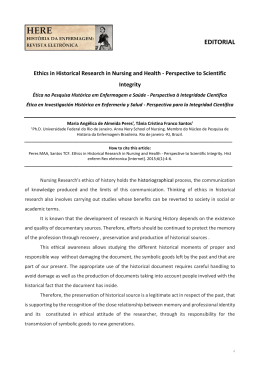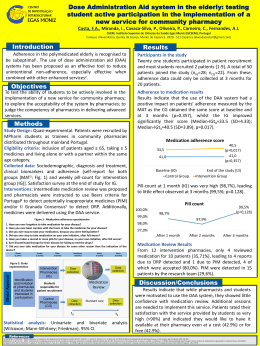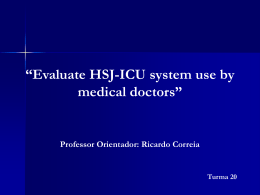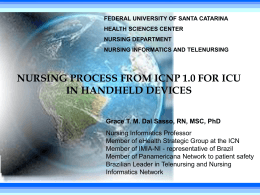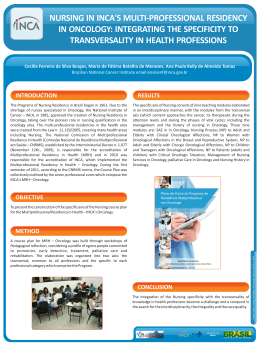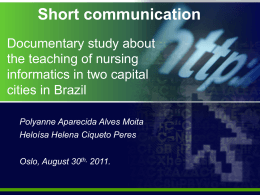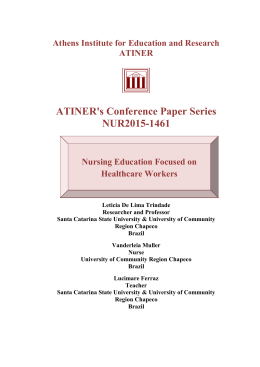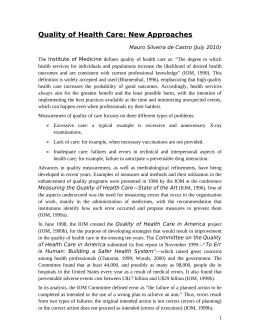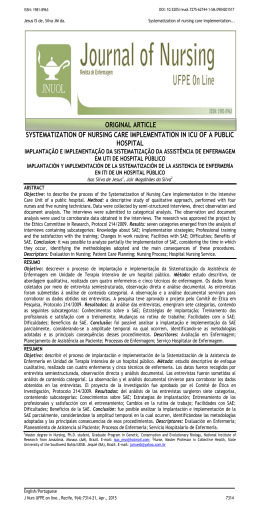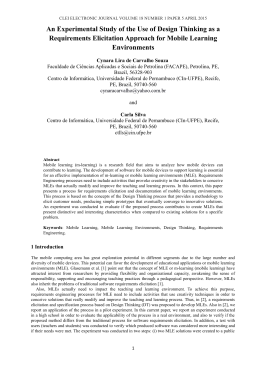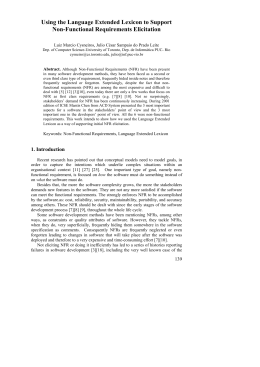Safety in medication preparation and administration, in light of restorative health care research Case Report SAFETY IN MEDICATION PREPARATION AND ADMINISTRATION, IN LIGHT OF RESTORATIVE HEALTH CARE RESEARCH* SEGURANÇA NO PREPARO E NA ADMINISTRAÇÃO DE MEDICAMENTOS, À LUZ DA PESQUISA RESTAURATIVA EM SAÚDE SEGURIDAD EN LA PREPARACIÓN Y ADMINISTRACIÓN DE DROGAS A LA LUZ DE LA INVESTIGACIÓN RESTAURATIVA EN SALUD Fernanda Raphael Escobar Gimenes 1 Silvia Helena De Bortoli Cassiani 2 Article was part of a doctoral thesis, “Patient safety regarding medication administration in an intensive care unit of a general hospital in São Paulo State: a restorative approach in health”, presented at the Universidade de São Paulo – Ribeirão Preto. * Nurse. Doctorate in Nursing Sciences. Professor at the Universidade de São Paulo – Ribeirão Preto, EERP-USP. Ribeirão Preto, SP – Brasil. 2 Nurse. Doctorate in Nursing. Full Professor and Dean at the Universidade de São Paulo – Ribeirão Preto, EERP-USP. Ribeirão Preto, SP – Brasil. 1 Corresponding Author: Fernanda Raphael Escobar Gimenes. E-mail: [email protected] Submitted on: 05/09/2013 Approved on: 10/10/2013 ABSTR ACT The objective was to obtain the views of the nursing professionals from an intensive care unit (ICU) of São Paulo State, in relation to the aspects existing in the processes of medication preparation and administration that, according to professionals, may contribute to patient safety or, on the other hand, may be seen as barriers to safe medication administration. The study was divided into four phases. We used diverse data collection techniques: focus groups, photo narration, photo elicitation, and field observation. Data collection and analysis proceeded in an iterative fashion, according to the restorative approach to health systems research. Six themes were obtained from the analysis: identifying the healthcare environment as a contributor to safety in medication preparation and administration; identifying risks in the healthcare environment; realizing environmental care as a risk factor for occupational accidents; having to live with the feeling of “impotence” in the face of prevailing organizational culture; living with workaround on a day-to-day basis; and glimpsing possibilities of changes in the healthcare environment. The experience of using the restorative approach to health systems research helped the understanding of the barriers and the measures aimed at the safety of medication preparation and administration. The themes obtained also showed that the existing problems in the ICU affect the safety of both patients and professionals. Therefore, leaders should review how to manage safety within the institution. Keywords: Safety Management; Patient Safety; Intensive Care Units; Environmental Remediation; Research; Photography. RESUMO O objetivo foi obter a visão dos profissionais de enfermagem de uma unidade de terapia intensiva (UTI) do interior paulista, em relação aos aspectos existentes nos processos de preparo e de administração de medicamentos, o que, segundo os profissionais, contribui para a segurança do paciente ou, ao contrário, são vistos como barreiras para a administração segura dos medicamentos. O estudo foi dividido em quatro fases. Foram utilizadas técnicas diversificadas de coleta de dados: grupos focais, narração fotográfica, foto elicitation e observação em campo. A coleta e a análise dos dados ocorreram de maneira interativa, segundo a orientação teórica da pesquisa restaurativa em saúde. Seis temas foram obtidos da análise: identificando o ambiente assistencial como contribuinte para a segurança no preparo e na administração de medicamentos; identificando riscos no ambiente assistencial; percebendo o ambiente assistencial como fator de risco para os acidentes ocupacionais; tendo que conviver com o sentimento de “impotência” diante da cultura organizacional vigente; convivendo com os improvisos no dia-a-dia do trabalho; e vislumbrando possibilidades de mudanças no ambiente assistencial. A experiência de utilizar a abordagem restaurativa em saúde auxiliou na compreensão das barreiras e das medidas facilitadoras voltadas para a segurança no preparo e na administração de medicamentos. Os temas obtidos também demonstraram que os problemas existentes na UTI interferem na segurança tanto dos pacientes como dos profissionais. Logo, os líderes devem rever a forma de gerenciar a segurança na instituição. Palavras-chave: Gerenciamento de Segurança; Segurança do Paciente; Unidades de Terapia Intensiva; Remeduação Ambiental; Pesquisa; Fotografia. RESUMEN El objeto del presente trabajo fue conocer la opinión de los profesionales de enfermería de una unidad de cuidados intensivos (UCI) del Estado de San Pablo sobre los aspectos de los procesos de preparación y administración de medicamentos que contribuyen a la seguridad del paciente o que son considerados como obstáculos para la administración segura de medicamentos. El estudio se dividió en cuatro etapas. Se utilizaron varias técnicas de recogida de datos: grupos focales, fotografía narrativa, foto elicitation y observación de campo. La recogida y análisis de datos se llevaron a cabo de manera interactiva, según la orientación teórica de la investigación restaurativa en salud. Del análisis se obtuvieron seis temas: Identificación del DOI: 10.5935/1415-2762.20130070 975 REME • Rev Min Enferm. 2013 out/dez; 17(4): 975-983 Safety in medication preparation and administration, in light of restorative health care research entorno sanitario como factor que contribuye a la seguridad en la preparación y administración de medicamentos; Identificación de riesgos en el entorno sanitario; Consciencia de que el ambiente hospitalario puede ser un factor de riesgo para los accidentes de trabajo, Vivir con la sensación de “impotencia” ante la imperante cultura de la organización, Convivir con los imprevistos del día a día laboral, Vislumbrando las posibilidades de cambios en el entorno sanitario. La experiencia de emplear el enfoque restaurativo en salud ha ayudado a comprender los obstáculos y las medidas facilitadores destinadas a la seguridad en la preparación y administración de medicamentos. Los temas obtenidos también han demostrado que los problemas existentes en las UCI inciden tanto en la seguridad de los pacientes como de los profesionales. Por ese motivo los administradores deben rever la gestión de la seguridad en la institución. Palabras clave: Administración de la Seguridad; Seguridad del Paciente; Unidades de Cuidados Intensivos; Remediación Ambiental; Investigación; Fotografía. Introduction powerment, and gives voice to those who are considered “oppressed” by complex systems full of uncertainties, such as the hospital environment. The restorative health approach was used in this investigation considering that “professionals are able to recognize problems, analyze their different conformations, assume the conflicts of daily work, and autonomously look for ways to reinvent/recreate work alternatives”. This approach also allows the health team to work together toward an efficient, ethical and safe care environment.7, 8 We also chose the restorative approach in health for its innovation in national studies, as a potential proposal based on scientific evidence whose disclosure could support Brazilian research on the studied theme, in addition to favoring a decision making process that directs the future of organizations.3, 9-11 In the twenty-first century, one of the biggest challenges for hospitals is to follow the many technological and scientific advances occurring in the care context. However, not only does health care change over time, but the severity of diseases also changes. In recent years, the changes in demographic and epidemiological profiles are associated with an increase in hospitalizations of people presenting with chronic and degenerative conditions in hospitals around the world.1 The change in these profiles requires the incorporation of new healthcare technologies into patient care, as well as new therapeutic interventions and the use of complex drugs in treatment. While searching for balance, hospitals and other healthcare institutions seek to adapt to these changes, using temporary strategies to deal with urgent problems. These strategies are often precarious and aimed at minimizing the apparent consequences of problems, not taking into account the real causes, often resulting in risks to patient safety. According to the World Health Organization, one in every ten hospitalized patients is the victim of care-related adverse events during patient care in structured and technologically advanced hospitals. It is believed that this reality is even worse in developing and / or transitional countries.2 There is a need for health research projects from different areas of knowledge, and innovative approaches that involve quality of care and patient safety.2 Among these, we highlight the restorative approach, which aims to strengthen the relationship between people and environments in which they operate.3-6 In restorative health research, researchers encourage the participation of people in data collection and use participant narratives in order to examine the lives and experiences of individuals or groups, while focusing on the comprehension of the phenomenon under study. The involvement of the study subjects in these investigations allows people to analyze their professional practices in an attempt to improve them. When reflecting on the problems experienced in their daily lives, whether they be economical, physical, social or cultural, people are able to identify and propose possibilities of change. This type of research emphasizes subjects´ perspectives, favors emDOI: 10.5935/1415-2762.20130070 OBJECTIVES To obtain the perspective of nursing professionals from an Intensive Care Unit (ICU), regarding the care environment in which the processes of preparation and administration of medications take place, according to the restorative approach to health research. We also aimed to identify the aspects considered by the nursing staff as factors that contribute to patient safety or, in contrast, factors perceived as barriers to a safe medication administration. METHODOLOGY This study was conducted in a general ICU of a mediumsized hospital in the state of São Paulo, after approval by the Ribeirão Preto School of Nursing Board of Ethics in Research, University of São Paulo (Process 1096/2009). The ICU had 10 beds and was also a clinical placement facility for nursing students (technical and undergraduate degree) from the nearby region. The staff was composed of 27 nursing professionals, with 22 nursing technicians and five graduated nurses. A total number of 23 nursing professionals and one intensivist participated in the study. All were previously invited to participate in the study, and did so voluntarily, and after signing the Terms of Free and Informed Consent form. 976 REME • Rev Min Enferm. 2013 out/dez; 17(4): 975-983 Safety in medication preparation and administration, in light of restorative health care research The ICU was selected for this study because of its complexity, high availability of technological devices, and therefore it was considered vulnerable to adverse events and medication errors. One hospitalized patient in an ICU receives around 178 interventions per day, and 1% of these involve medication errors. Mortality in ICUs of the United States of America is estimated around 8-10%, resulting in 400,000 to 500,000 deaths per year.12 In Brazil, the reality is no different, and has been described in several studies.13-15 The study was divided into four phases. The first aimed to describe the care environment of the nursing staff in the processes of medication preparation and administration. In the second phase, we focused on documenting safe and unsafe practices in these processes by means of photographic records and visual narratives. In the third phase, the goal was to evoke reflections of professionals through images about potential changes to be implemented in the medication system and the healthcare environment. The fourth phase aimed to document, through photographic records, modifications within the ICU four months after the implementation of the changes suggested by the study participants. Before data collection, meetings with the hospital manager were held in order to present the research project, its objectives, methodology and data collection techniques. The study was disclosed after approval of the hospital manager, and a recruitment folder for focus groups was located in the ICU. After one week, the researcher returned to the unit and explained the objectives of the study and the methodologi- cal and ethical procedures to ICU nurses. At this meeting, the researcher asked the professionals about probable dates and times for focus group (FG) sessions. With an established schedule, a bulletin board was located in the ICU a month prior to the first focus group session. These contacts were important for professional adherence to the study groups. Later, data collection, categorization and interactive analysis was initiated, according to the theoretical framework of restorative health research (Figure 1).3, 5, 10 The interactive data analysis is considered a reflexive process, whose goal is to generate knowledge and promote the development of meanings. This type of analysis involves three basic questions that must be answered along the process: what does the data tell me? What do I want to know from the data? What existing dialectical relationship exists between what the data tell me and what I aim to know?16 The first question seeks to identify the initial points of interest that the researcher needs to observe, based on the study questions. The second aims to refine these issues, while the third proposes to integrate the data set (narratives and photos) through the intersection of information obtained during the study. This crossing process allows the researcher to identify possible gaps in data collection and to understand what is happening among the participants, and between them and their environment. In this context, the researcher may encounter some issues that require further clarification from the participants of the study, which should be answered in the subsequent stages of the research. Figure 1 - Data collection, categorization and interactive analysis, according to the theoretical framework of restorative health research. Source: adapted from Creswell.29 DOI: 10.5935/1415-2762.20130070 977 REME • Rev Min Enferm. 2013 out/dez; 17(4): 975-983 Safety in medication preparation and administration, in light of restorative health care research Due to the methodological design used in this research, the description of data collection, data categorization and analysis were performed concomitantly. A summary of the methodological procedures used in data collection, categorization, and interactive analysis (Table 1) is presented as follows. Phase 1 – Focus group 1 (FG1): the care environment and the processes of medication prepar ation and administr ation in the ICU, according to nursing staff perspectives Focus groups (FG) represent a research technique that allows the collection of qualitative data from group sessions in which six to 15 people share a common characteristic and discuss various aspects of a specific topic.17 The objective is to develop ideas, obtain insights, discuss concerns and perceptions in an open and rich learning environment.18 In general, the FG formation is intentional and composed of participants that share similarities such as, for example, the fact of working in the same setting. This favors the reporting of experiences, and the identification of needs, values and beliefs that surround the theme of the phenomenon under study.19,20 Therefore, the FG was used in this investigation to allow the emergence of perceptions of nurses, representations and opinions around safety aspects, and to explore the experience and creativity of the participants in order to provide local autonomy and enhance nursing practice. The technique was also employed aiming to encourage more engagement of the nursing staff in the identification of barriers and possibilities of changes focused on maintaining safe practices, and rethinking unsafe procedures of medications preparation and administration. In this phase, six FG sessions were performed. A semistructured script that contained open-ended questions was used. The six group sessions were recorded and had a maximum duration of 60 minutes. At the end of each group, a summary of what was discussed was developed, and then a short time was opened up for participants to add, change or clarify any idea referred to during the sessions. Table 1 - Summary of the procedures adopted for data collection, organization and interactive analysis Phase 1 2 3 4 Period Research question Participants Technique Instruments Analysis January/ 2010 1. How does the ICU nursing staff perceive the hospital medication system? 2. How does the ICU nursing staff perceive the environmental context in which the medication processes occur (prescription, dispensing, preparation and administration of medications)? Nurses and nursing technicians Six sessions of focus groups (GF1) Digital recorder, list of topics to guide discussions Transcription, coding, categorization and emerging themes March/ 2010 3. What aspects related to the medication system do the nursing staff identify as contributors to patient safety, considering the ICU setting where the preparation and administration of drugs occur? 4. What aspects related to the medication system do the nursing staff identify as related to adverse drug events, near misses and medication errors, considering the ICU setting where the preparation and administration of drugs occur? Nursing service manager Two sessions of photographic narrative Digital camera Fujifilm Finepix S2000 HD; protocol for digital photography; digital photography registration form; field observation diary; list of problems; digital recorder Interactive analysis (narratives and photos). Transcription, coding, categorization and emerging themes May/ 2010 5. What potential changes does the nursing staff identify as feasible and desirable for the management of patient safety in drug therapy, considering the ICU work environment and the hospital medication system, processes, practices and policies? Nursing service manager, nurses, nursing technicians and intensivist One session of focus groups (FG2) and photo elicitation 12 photographs and a theme presented in Microsoft Power Point® slides, list of topics for discussion in the FG2, digital recorder Interactive Analysis (narratives and photos). Transcription, coding, categorization and emerging themes September/ 2010 6. To register changes related to drug therapy, suggested after the focus groups, in the medication system and its processes, as well as in the healthcare environment and among nursing staff. Nursing service manager, nurses, and nursing technicians Two sessions of field observation and photographic records Digital camera Fujifilm Finepix S2000 HD and photographs taken during the phase 2 Comparison of photographs taken "before" and "after" the focus groups Source: the authors. DOI: 10.5935/1415-2762.20130070 978 REME • Rev Min Enferm. 2013 out/dez; 17(4): 975-983 Safety in medication preparation and administration, in light of restorative health care research In all FG sessions, two trained research assistants accompanied the principal investigator. At the end of each group, the researcher met with the assistants in a private room of the hospital to discuss and record insights, exchange ideas and evaluate the session, and to plan the next one. The data collection, organization and analysis occurred interactively (Figure 1). Based on the results of this analysis, we developed a list of topics focused on the medication and care systems for the ICU environment in which the preparation and administration of medications occurred, in order to conduct the photographic records and the visual narratives of the study second phase. Phase 2 – Photogr aphic Narr ative (NF): documentation of safe and unsafe pr actices in the processes of prepar ation and administr ation of medications Research involving visual techniques are widely used in the fields of Anthropology, Communication, Psychology and Sociology.21 In these areas, the use of photographic cameras has become a major instrument for data collection, and because of improved image quality, in addition to an easy handling and cost savings, these devices are today used in numerous studies.22 The photographic narrative consists in combining a series of photographs followed by narratives in order to create stories through images. The technique is employed in small groups of dialogue aiming to stimulated people’s abilities to act individually and collectively regarding social change, once it uses photography of daily life as an educational tool to record and reflect on these groups needs, promote discussion, encourage actions and clarify policies.23, 24 In the photographic narrative, questions are broad, with the goal of helping professionals to reflect their context and identify weaknesses and vulnerabilities of the system and it processes so that strategies for change are collectively elaborated. The technique consists in the ability to retell the story in the present, through the observation of something that happened in the past, and with the aim of rethinking the future.25 Based on these assumptions, the technique of photographic narrative was essential to achieve the proposed research objectives. Its purpose was to photograph and record the daily problems faced by nursing professionals that could contribute to medication errors. The photographic narrative occurred in two sessions and was based on the list of topics from FG1 data analysis. The camera remained with the researcher, while an experienced nurse retold the context of the problems on the list, trying to establish causes and reflecting on possible changes in organizational culture, in regulations, and in the daily practices and procedures related to drugs preparation and administration routines in the ICU. DOI: 10.5935/1415-2762.20130070 In this phase, two research assistants also accompanied the principal investigator. One assistant made notes of the photographed areas on an observation field form, and the second assistant kept the voice recorder next to the nurse to accurately capture the narrative. Data from the photographic narrative (narrative and photographs) were analyzed interactively following the theoretical orientation of restorative health research (Figure 1). In order to guide the focus groups during the third stage (FG2 – Photo elicitation), the researcher chose 12 photographs and a question (“Which attitudes against errors are being taken?”) to be discussed with study participants. The photos and the theme were selected in order to explore with more detail the aspects related to patient safety in the preparation and administration of medications in the ICU. Thus, the selected photographs met the following eligibility criteria: 1. the photographs illustrated issues that allowed the researcher to elaborate further questions about the studied phenomenon; 2. the photographs depicted aspects of the system and/or the care environment, that needed to be clarified by the nursing staff; 3. the photographs presented various codes and therefore several issues that could be portrayed and discussed with the participants. After the selection of theme and photographs, these were transferred to a Microsoft PowerPoint® slideshow. Each slide contained a simple title, which portrayed the most important aspect to be discussed in the group, and a photograph, since many images could cause confusion during the discussion. When the data analysis step was completed, the researcher posted another folder for recruitment, inviting ICU nurses to participate in the FG2 (photo elicitation). Phase 3 – Focus Group 2 (FG2) – photo elicitation: to evoke, through images, reflections about potential changes to be implemented in the ICU medication system and in the ICU care environment Photo elicitation is a technique in which photographs taken either by the researcher or study participants are inserted into interviews and/or FG session. Thus, photographs are used as a stimulus or a guide to encourage detailed reports on the phenomenon under study. This is a widely used technique in ethnography and anthropology, which is becoming popular in the fields of sociology, psychology, and more recently, in nursing.3, 26 979 REME • Rev Min Enferm. 2013 out/dez; 17(4): 975-983 Safety in medication preparation and administration, in light of restorative health care research The technique involves the stimulation of discussions about the culture and practices of a given context from the visualization of images. The researcher becomes a listener who will encourage the participants to maintain the continuity of the dialogue. The technique also allows pictures to be used for a new historical understanding of a specific reality.27 When used with interviews/FG sessions, photo elicitation is a valuable tool for its capacity of grouping data and collaborating to empower study participants, to the extent that it teaches the researcher about aspects of reality, and strengthens testimonials, bringing to light issues that would not be said in formal discussions.21, 28 In this phase, the photographs were presented to study participants during the FG2. This phase aimed to evoke, through images, potential changes to be implemented in the medication system, in the processes, practices, policies, organizational culture and ICU care environment that, according to the nurses, could promote patient safety during preparation and administration of medications. The photo elicitation occurred in one session with a maximum duration of 60 minutes, and was recorded for later transcription. A total of seven professionals composed of the service manager, the supervisory nurse, four technical nurses and one intensivist participated in the FG2. Participants were asked to view photographs and share their experiences and perspectives related to patient safety, to discuss the facilitating measures and barriers that hindered the safe preparation and administration of medications. While seeing the photographs, participants proposed a total of 30 potential changes to be implemented in the ICU (Table 2). It is worth noting that at the end of the interactive data analysis from the FG1, the photographic narrative (photo elicitation) and data from the FG2, the codes, categories and themes were confirmed with the nursing staff. Adjustments were made based on participant suggestions, so that the final themes portrayed the nursing staff perceptions about the factors that benefited safety or, instead, that may contribute to medication errors. Phase 4 - Documentation of changes in the processes of prepar ation and administr ation of medications Four months after the FG2 (photo elicitation), the researcher returned to the ICU with the aim of verifying through field observation, and registering through photographs, the changes in the ICU proposed in the FG sessions. Table 2 - Identification of potential changes to be implemented in the ICU Potential changes suggested by the ICU staff Short term Medium term Long Term Provide educational material to consult for drug information Rearrange spaces inside the ICU Electronic drug prescription DEF (Pharmaceutical dictionary) available online Replace the sink with a larger one Separating counter for medication preparation from the nursing station Standardize the names of drugs, replacing the commercial name with the name of its substance Reposition cans for trash and biohazardous waste at the nursing station Change the nomenclature of drugs directly in the system Conduct trainings for ICU staff Increase the number of drawers Collaboration of laboratories in relation to the similarity between drug ampoules Review the schedule of trainings Standardize drug dilutions and sedation preparation Dispense liquid medications in unit doses Prepare prescriptions overnight Review the maintenance of medications tubes in the ICU Nurse performing the scheduling of medicines Pharmacy service within the hospital Categorize the color of the ampoules of emergency drugs – – Replace the DEF (pharmaceutical dictionary) with the Guanabara medical dictionary – – Include educational training in the bank of working hours Review the size of the plastic tapes Add partitions within the drawers of materials – – Condition insulin in a jar in the fridge – – Tiling the wall of the counter where medicines are prepared – – Encourage staff proactivity – – Source: the authors. DOI: 10.5935/1415-2762.20130070 980 REME • Rev Min Enferm. 2013 out/dez; 17(4): 975-983 Safety in medication preparation and administration, in light of restorative health care research The photographs were taken on two non-consecutive days and had the support of the service manager, the supervising nurse and the nursing technicians. These professionals guided the researcher throughout the facility in order to detect changes in the ICU. They also identified changes focused on patient safety in ICU policies and organizational culture. Photographs taken at that stage were stored in a password-protected computer so that only the researcher had access to the file. For subsequent comparison of “before” and “after” change implementation, the photographs were inserted in a Microsoft PowerPoint® file. Each slide contained a photograph taken during phase 2 (which corresponded to “before” changes) and, next to it, the photo taken during phase 4 (which corresponded to “after” changes). Each pair of photographs was analyzed, with the aim of registering changes focused on patient safety in the preparation and administration of medications in the ICU, and in its processes. Data from interactive analysis resulted in six final themes: a) identifying the healthcare environment as a contributing aspect to safety in the preparation and administration of drugs; b) identifying risks in the healthcare environment; c) perceiving the healthcare environment as a risk factor for occupational accidents; d) dealing with the feeling of “helplessness” in the face of prevailing organizational culture; e) dealing with improvisation in the daily work; f) seeing possibilities of changes in the healthcare environment (Table 3). The themes revealed that, despite the fact that the medication system and the care environment of the ICU present a diversity of problems, participants envisioned possibilities for change in order to improve quality and safety in the care provided to patients. Table 3 - List of themes and categories from the interactive data analysis THEMES CATEGORIES Identifying the drug distribution in plastic ribbons as a safer system Perceiving the material and medicine stock as being organized Returning medicines that remained in the unit A - Identifying the healthcare environment as a contributing aspect for safety in the preparation and administration of drugs Identifying the ICU nursing staff as experienced Searching for information on medicines in case of questions Perceiving relationships of trust among members of the ICU team Identifying risk of medication errors related to prescriptions Identifying errors in the pharmacy dispensing system Having trouble communicating with the pharmacy Identifying infrastructure problems at the nursing station B - Identifying risks in the healthcare environment Having difficulties clarifying questions about drugs in the pharmaceutical dictionary Identifying similarities among different ampoules and vials/bottles Identifying unsafe practices related to the presence of new and inexperienced employees in the ICU Perceiving sources of distraction during medication preparation Having to travel long distances during the workday C - Perceiving the healthcare environment as a risk factor for occupational accidents Identifying the arrangement of furniture as a risk factor for occupational accidents Perceiving the emergency cart as too heavy Being in danger of a biological accident Being afraid of being fired after the occurrence of a medication error D - Dealing with the feeling of “helplessness” in the face of the prevailing organizational culture Feeling helpless due to the institution Perceiving a lack of risk management policies in the institution Perceiving a lack of motivation of the nursing team E - Dealing with improvisation in the daily work Lack of funding/physical space favors improvisation Perceiving that improvisation is necessary in drug administration to patients Identifying possibilities for change in the short term F - Seeing possibilities for change in the healthcare environment Identifying possibilities for change in the medium term Identifying opportunities for change in the long term Source: the authors. DOI: 10.5935/1415-2762.20130070 981 REME • Rev Min Enferm. 2013 out/dez; 17(4): 975-983 Safety in medication preparation and administration, in light of restorative health care research The restorative health research contributed to the professionals´ identification of the aspects of the system and its processes that were adequate and should be maintained, as well as those that may hinder patient safety, which must be rethought and redesigned. The suggestions for change interventions were subdivided into short, medium and long term, as several interventions did not require much financial, human, physical, and materials resources. As for the data collection techniques used in this study, focus groups and photographic storytelling allowed the involvement of nursing professionals with safety aspects, through a critical and reflective analysis of themselves, their relationships with others and with the healthcare environment. The techniques incentivized them to correct the problematic areas of this complex system. It was possible to build a collective knowledge between the nursing staff and the researcher, during visits to the facility, exchanging views and experiences about the meanings attributed to the study phenomenon. The photo elicitation allowed participants to describe their perceptions from previous experiences in order to rethink the future. The result of this process was the development of 30 potential changes to be implemented in the ICU and in the hospital. In the fourth phase, four months after the photo elicitation, some of the changes suggested by the participants were captured, using photographic records. From the collective construction of knowledge between the researcher and subjects, the results obtained in this investigation provided information for further studies. The results also revealed that the existing problems in the ICU interfered with the safety of both patients and professionals, and that the institution must review its way of managing safety issues. The experience of using restorative health approach helped in understanding the barriers and the facilitating measures aimed toward patient safety in the preparation and administration of medications. It also allowed us to rethink safety of the professionals in the intensive care environment. We expect restorative research in health to be used further in different scenarios where nursing staff operate, aiming to enable safety in the processes of preparation and administration of medications, and patient safety consequently. This study aim to influence institutions to adopt a participatory management model, in which work of the front-line professionals was integrated with the organizational leaders, focused on building a collective knowledge around weaknesses of their systems and their environments, in order to develop new ways to solve problems that pervaded safety of the patients and professionals. Organizational leaders, educators, students and researchers interested in understanding the complex and multifaceted factors influencing patient safety may benefit from the methods employed in this study. FINAL CONSIDER ATIONS 2. In the first phase of the research (FG1), study participants were concerned with diagnosing difficulties, problems and risks identified in the ICU that could favor medication errors. However, professionals also identified facilitative measures that, according to their perspective, were capable of improving safety in the preparation and administration of medications. The second phase (photographic narrative) favored a collective reflection on the problems existing in the system, in the healthcare environment and in the organizational culture, which could endanger patients. However, possibilities of change also began to emerge. The third phase (FG2 – photo elicitation) consisted of professionals recognizing that change was possible and desirable to promote a safe environment for both patients and professionals, and the mobilization of all stakeholders was essential to achieve this goal. 3. Marck PB, Kwan JA, Preville B, et al. Building safer systems by ecological design: using restoration science to develop a medication safety intervention. Qual Saf Health Care. 2006;15(2):92-7. DOI: 10.5935/1415-2762.20130070 ACKNOWLEDGMENTS We thank Professor Dr. Patricia Marck for the support in understanding the theorical framework regarding the restorative approach in health research. We acknowledge the nurses, Ariadne Eleonora Trombert da Silveira and Lígia Dorly Trombert da Silveira, for their valuable contribution to data collection. REFERENCES 1. World Health Organization. Global status report on noncommunicable diseases 2010. Geneva: World Health Organization; 2011. ix, 164 p. World Health Organization. WHO Patient Safety. WHO patient safety research: better knowledge for safer care. Geneva: World Health Organization; 2009. 12 p. 4. Marck P, Cassiani SHdB. [Theorizing about systems: an ecological task for research in the area of patient safety]. Revista Latinoam Enferm. 2005; 13:7503. (Portuguese). 5. Marck P. Field notes from research and restoration in the backcountry of modern health care. Can J Nurs Res. 2006; 38(2):11-23. 6. Marck PB. Ethics in hard places: the ecology of safer systems in modern health care. Health Ethics Today. 2004; 14(1):4. 7. Guedes RMDA, Lima FDPA, Assunção AA. [The quality program in the hospital sector and the actual activities of nursing: the case of medication]. Ciênc Saúde Coletiva. 2005; 10:1063-74. (Portuguese). 8. Hassan E, Badawi O, Weber RJ, Cohen H. Using technology to prevent adverse drug events in the intensive care unit. Crit Care Med. 2010; 38(6Suppl):S97-S105. 9. Lockett D, Willis A, Edwards N. Through seniors’ eyes: an exploratory qualitative study to identify environmental barriers to and facilitators of walking. Can J Nurs Res. 2005; 37(3):48-65. 982 REME • Rev Min Enferm. 2013 out/dez; 17(4): 975-983 Safety in medication preparation and administration, in light of restorative health care research 10. Marck PB, Lang A, Macdonald M, Griffin M, Easty A, Corsini-Munt S. Safety in home care: a research protocol for studying medication management. Implement Sci. 2010; 5:43. 20. Ressel LB, Beck CLC, Gualda DMR, Hoffmann IC, Silva RMd, Sehnem GD. [The use of focus groups in qualitative research]. Texto Contexto Enferm. 2008; 17:779-86. (Portuguese). 11. Raduenz AC, Hoffmann P, Radunz V, Dal Sasso GT, Maliska IC, Marck PB. Nursing care and patient safety: visualizing medication organization, storage and distribution with photographic research methods. Rev Latinoam Enferm. 2010; 18(6):1045-54. 21. Maurente V, Tittoni J. [Images as a methodological strategy in research: a photocomposition and other possible pathways]. Psicol Soc. 2007; 19:33-8. (Portuguese). 12. Gallesio AO. Improving quality and safety in the ICU: a challenge for the next years. Curr Opin Crit Care. 2008; 14(6):700-7. 13. Toffoletto MC, Padilha KG. Consequences of medical errors in intensive and semi-intensive care units. Rev Esc Enferm USP. 2006; 40(2):247-52. 14. Bohomol E, Ramos LH, D’Innocenzo M. Medication errors in an intensive care unit. J Adv Nurs. 2009; 65:1259-67. 15. Mendes W, Martins M, Rozenfeld S, Travassos C. The assessment of adverse events in hospitals in Brazil. Int J Qual Health Care. 2009; 21:279-84. 16. Srivastava P, Hopwood N. A practical iterative framework for qualitative data analysis. Int J Qual Methods. 2009; 8(1):9. 17. Faria Westphal M, Bogus CM, Mello Faria Md. [Focus groups: precursor experiences in educational programs in health in Brazil]. Boletín de la Oficina Sanitaria Panamericana (OSP). 1996; 120(6):472-82. (Portuguese). 18. World Health Organization. World alliance for patient safety: WHO draft guidelines for adverse event reporting and learning systems: from information to action. Geneva: World Health Organization; 2005. 22. Neiva-Silva L, Koller SH. [The use of photography in the research in psychology]. Estudos Psicol. 2002; 7(2):13. (Portuguese). 23. Wang C, Burris MA. Empowerment through photo novella - portraits of participation. Health Educ Q. 1994; 21(2):171-86. 24. Wang C, Burris MA. Photovoice: concept, methodology, and use for participatory needs assessment. Health Educ Behav. 1997; 24(3):369-87. 25. Higgs ES. Nature by design: people, natural process, and ecological design. Cambridge: Mit Press; 2003. 26. Frith H, Harcourt D. Using photographs to capture women’s experiences of chemotherapy: reflecting on the method. Qual Health Res. 2007;17(10):1340-50. 27. Harper D. Talking about pictures: a case for photo elicitation. Visual Studies. 2002; 17(1):13. 28. Clark-Ibanez M. Framing the social world with photo-elicitation interviews. Am Behav Sci. 2004; 47(12):1507-27. 29. John WC. Research Design: qualitative, quantitative, and mixed methods approaches. Los Angeles: SAGE Publications; 2009. 19. Thorne S. Interpretive description. Left Coast Press; 2008. DOI: 10.5935/1415-2762.20130070 983 REME • Rev Min Enferm. 2013 out/dez; 17(4): 975-983
Download
